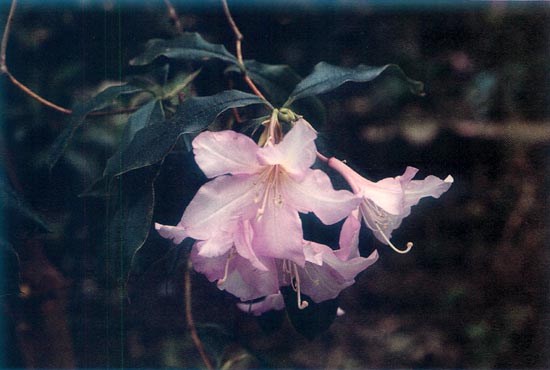JARS v45n4 - Intriguing Rhododendron stenaulum
Intriguing Rhododendron stenaulum
Felice Blake
Kallista, Victoria, Australia
Tucked away in Subgenus Azaleastrum, Section Choniastrum (formerly the Stamineum Series), we find the rather intriguing and decidedly exotic Rhododendron stenaulum . This unusual rhododendron was discovered in April, 1910, by George Forrest (as R. mackenzianum ) in western Yunnan, on the Shweli-Salween divide. It was first described by Balfour and W.W. Smith in 1917, as R. stenaulum . Since that time it has been rediscovered in southeast Xizang (Tibet), north Burma and Arunachal Pradesh.

|
|
R. stenaulum
Photo by Felice Blake |
This rhododendron usually grows as a shrub up to about 5 metres, although some authorities state up to 15 metres. The plant with which I am familiar grows in one of the renowned gardens in the Dandenong Ranges, about 20 miles east of Melbourne, and is now about 3 metres having been received in 1976 as a tiny rooted cutting. At all times of the year, it creates interest, from the flowering time early in the season. Then one becomes aware of its rich smooth mahogany bark, later peeling, to reveal new green bark underneath which gradually turns to tan before acquiring its true mahogany colour. As I am writing I am looking at several pieces of bark picked today, absolutely fascinating and very like fine, almost transparent pieces of rare parchment. The 15-centimeter leaves are dark green above, paler beneath, whilst in spring the edges of the new leaves are touched with bronze.
The inflorescence is axillary, with unusual long pointed buds which have been likened to those of a Luculia with the long tube. The quite large flowers with spreading lobes open in loose clusters, and are a delicate silvery-lilac with a delightful perfume reminiscent of jasmine. There are other colour forms but I have not seen them, and Peter Cox reports seeing an outstanding white form in northeast India. Regrettably this has not been introduced. As with many other species there seem to be many goals for further exploration.
R. stenaulum received the Royal Horticultural Society's Award of Merit in 1937 when exhibited by L. de Rothschild, Exbury, and the Earl of Stair, Stranraer. Although this species has been in cultivation for a long time, it does not seem nearly as well known as it should be, and in mild climates it deserves far more attention. It does seem unlike any rhododendron with which I am familiar, and has much to offer with its very distinctive flowers and beautiful bark.
Felice Blake, a regular contributor to the Journal ARS, has written a number of rhododendron portraits, focusing her attention - and ours - on some outstanding species and hybrids.
